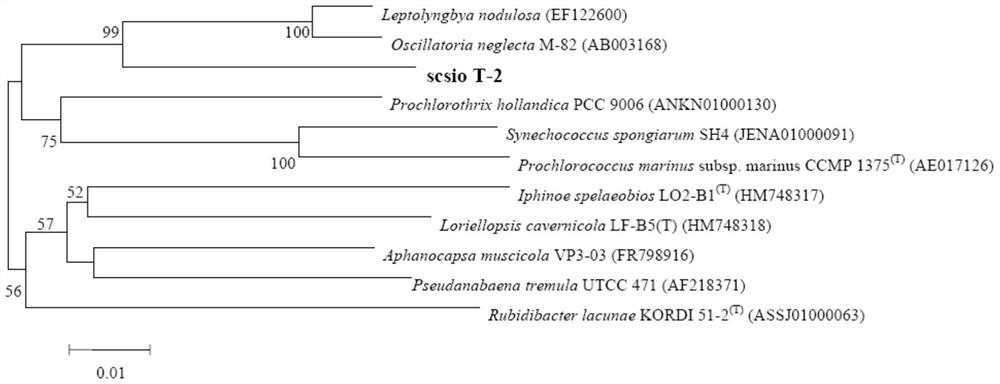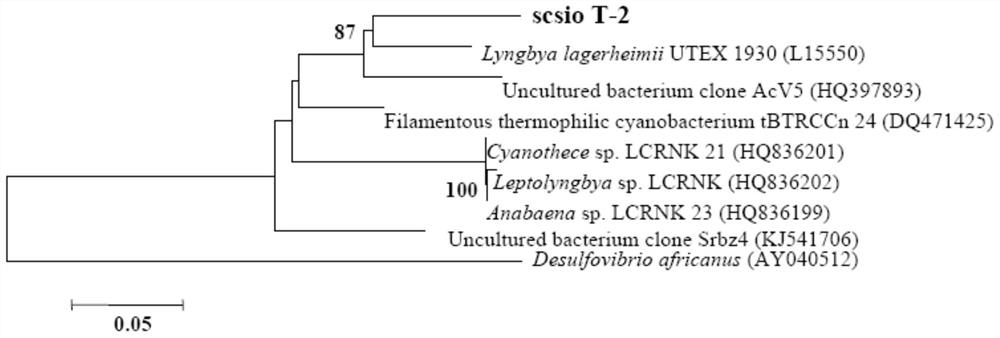A Leptinia scsio T-2 and its application
A technology of scsiot-2 and sheath filaments, applied in the biological field, to achieve good nitrogen fixation activity, broad application prospects, and high value effects
- Summary
- Abstract
- Description
- Claims
- Application Information
AI Technical Summary
Problems solved by technology
Method used
Image
Examples
Embodiment 1
[0019] Example 1: Isolation, purification and identification of Leptolyngbya sp. scsio T-2
[0020] 1. Isolation and purification of Leptolyngbya sp. scsio T-2
[0021] Collect the seaweed Thalias algae collected from Xincun Bay, Lingshui, Hainan Province, China, add seawater to scrub, and filter to obtain the cyanobacteria liquid. Pick cyanobacteria hyphae and culture them in marine cyanobacteria medium ATCC Medium 957, nitrogen-fixing cyanobacteria medium ATC Medium 819, marine nitrogen-fixing cyanobacteria medium ATCC Medium 1077 and BG-11Medium, and the continuous light intensity is 150μE / m 2 / s, the light cycle is 12:12h (light: dark cycle), the temperature is 23-27°C, in the light incubator (the model is LRH-250-GH microcomputer-controlled light incubator), every two weeks into fresh medium until the microscopic examination shows a single mycelium. The cyanobacteria scsio T-2 was obtained by separation and purification.
[0022] 2. Identification of Leptolyngbya sp. s...
Embodiment 2
[0036] The mensuration of embodiment 2 cyanobacteria indole acetic acid production
[0037] The salkowski colorimetric method was used to determine the ability of the isolate to produce plant growth hormone substances, and the standard curve was prepared using pure 3-IAA (3-indole acetic acid). Inoculate cyanobacteria scsio T-2 in 100mL selective liquid nitrogen-free liquid modified medium (formula is the same as in Example 1), and the continuous light intensity is 150 μE / m 2 / s, the light cycle is 12:12h (light: dark cycle), the temperature is 25-28°C, cultivate for 120h, take 5mL of the cyanobacteria culture supernatant every 24h, centrifuge at 10000r / min for 10min, take the supernatant and add colorimetric The solution was left to stand in the dark for 0.5h, taken out, and measured immediately with a spectrophotometer at a wavelength of 530nm (Glickmann and Dessaux Y.A).
[0038] Indole acetic acid content in the sample (μg / mg) = (A × V1) / (W × V2) × 1000
[0039] In the...
Embodiment 3
[0044] 16SRNA and nitrogen fixation gene amplification of the strain of embodiment 3
[0045] Select the pure bacterial strain cyanobacteria scsio T-2 obtained by separation and purification in Example 1 to carry out DNA extraction and purification. For the extraction and purification of DNA in this embodiment, its operation method refers to Dong Xiuzhu's "Common Bacteria System Identification Manual" P 409 . 1SF / 16SR (Weisenburg et al., 1991, 16S ribosomal DNA amplification forphylogenetic study., Journal of bacteriology, 1991 173(2): 697-703 and nifH gene general primer PolF / PolR (reference Poly et al. , 2001, Comparison of nifH Gene Pools in Soils and Soil Microenvironments with Contrasting Properties, Applied and Environmental Microbiology, 2001, 67 (5) 2255-2262) PCR amplification: PCR reaction system as shown in Table 1.
[0046] Table 1 PCR reaction system
[0047]
[0048] The PCR reaction conditions were: pre-denaturation at 95°C for 5min; denaturation at 95°C fo...
PUM
 Login to View More
Login to View More Abstract
Description
Claims
Application Information
 Login to View More
Login to View More - R&D
- Intellectual Property
- Life Sciences
- Materials
- Tech Scout
- Unparalleled Data Quality
- Higher Quality Content
- 60% Fewer Hallucinations
Browse by: Latest US Patents, China's latest patents, Technical Efficacy Thesaurus, Application Domain, Technology Topic, Popular Technical Reports.
© 2025 PatSnap. All rights reserved.Legal|Privacy policy|Modern Slavery Act Transparency Statement|Sitemap|About US| Contact US: help@patsnap.com



